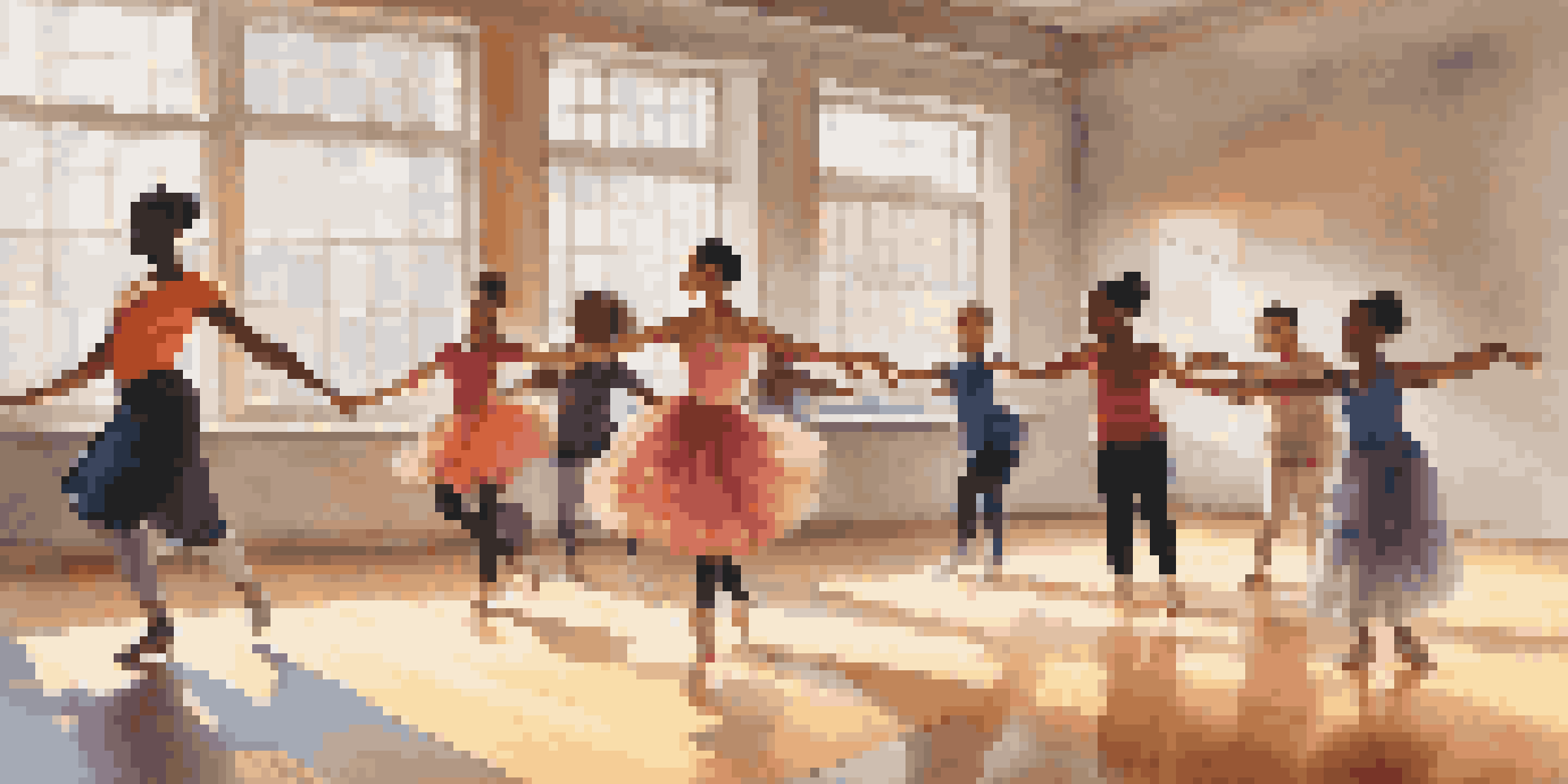The Therapeutic Power of Dance: A Holistic Approach

Understanding the Therapeutic Benefits of Dance
Dance is more than just a form of entertainment; it holds therapeutic benefits that can enhance mental and physical health. The rhythmic movement engages the body and mind, creating a unique blend that promotes emotional expression. For many, dance serves as a natural outlet for stress relief and self-discovery.
Dance is the hidden language of the soul.
Research shows that participating in dance can reduce symptoms of anxiety and depression. When we move, our brains release endorphins, commonly known as 'feel-good' hormones. This natural boost can uplift our mood and foster a sense of belonging within a community, making dance a powerful tool for emotional healing.
Moreover, dance encourages mindfulness, as it requires focus and presence in the moment. This practice can help individuals reconnect with their bodies, leading to greater body awareness and self-acceptance. The therapeutic power of dance lies not only in the action itself but also in the profound connections it fosters.
Dance as a Form of Expression and Communication
For many, words can be limiting when it comes to expressing feelings. Dance, however, opens a whole new world of non-verbal communication. Through movement, individuals can convey emotions that might be too complex or painful to articulate verbally.

Take, for example, someone who has experienced grief. They might find it difficult to share their sorrow with others. But through dance, they can channel that grief into movement, allowing themselves to process their emotions and share their story in a powerful way. This form of expression can lead to healing and understanding.
Dance Enhances Mental Health
Engaging in dance can significantly reduce symptoms of anxiety and depression while boosting self-esteem and overall well-being.
Furthermore, dance can bring people together, breaking down barriers and fostering empathy. When we watch someone dance, we often feel their emotions resonate within us. This shared experience can create connections that promote healing not just for the dancer but for the audience as well.
The Role of Movement in Physical Therapy
Dance is increasingly being recognized as an effective component of physical therapy. It incorporates a range of movements that enhance flexibility, strength, and coordination, making it an excellent tool for rehabilitation. Many physical therapists integrate dance into their sessions to make recovery more enjoyable and engaging.
The dance is a poem of which each movement is a word.
For instance, patients recovering from injuries might find traditional exercises monotonous. However, incorporating dance elements can make therapy feel more like a fun activity than a chore. This can motivate patients to participate more actively in their recovery process.
Additionally, dance can improve balance and prevent falls, especially in older adults. The dynamic movements involved in dance help strengthen muscles and improve proprioception, which is our body's ability to sense its position in space. This holistic approach to physical therapy emphasizes the joy of movement while promoting physical health.
Dance and Its Impact on Mental Health
The mental health benefits of dance are profound and well-documented. Engaging in dance can reduce stress, boost self-esteem, and enhance overall well-being. The act of dancing allows individuals to release pent-up emotions and tap into their creative selves, fostering a sense of freedom.
Studies have shown that regular participation in dance can lead to decreased levels of anxiety and depression. The social aspect of dance classes or groups also provides a support system, helping individuals feel less isolated. This communal experience can be incredibly beneficial for mental health.
Movement Aids Physical Therapy
Incorporating dance into physical therapy enhances flexibility, strength, and coordination, making rehabilitation more enjoyable.
Moreover, dance encourages a positive body image and self-acceptance. When individuals express themselves through movement, they often develop a deeper appreciation for their bodies and what they are capable of. This newfound confidence can translate into other areas of life, enhancing overall mental resilience.
Cultural Significance of Dance in Healing Practices
Throughout history, various cultures have used dance as a means of healing. Traditional dances often incorporate elements of spirituality and community, creating a powerful healing atmosphere. These practices emphasize the connection between the mind, body, and spirit, reinforcing the holistic nature of dance therapy.
For instance, in some Indigenous cultures, dance is integral to rituals aimed at healing both individuals and communities. These dances often involve storytelling and connection to ancestry, fostering a sense of belonging and purpose. Such practices highlight the importance of cultural context in understanding the therapeutic power of dance.
Additionally, modern dance therapy incorporates these cultural elements, acknowledging the diverse ways in which people use movement to heal. By integrating traditional practices with contemporary techniques, dance therapy can become a personalized healing journey that respects individual backgrounds and experiences.
Incorporating Dance into Daily Life for Wellness
Incorporating dance into daily routines can be a simple yet effective way to enhance overall wellness. Whether it’s a quick dance party in your living room or a structured class, moving to music can uplift your spirits and energize your day. The key is finding a style of dance that resonates with you.
Consider starting with just a few minutes of dancing each day. You can follow along with online dance tutorials, join a local class, or simply dance to your favorite songs. This not only contributes to physical fitness but also serves as a delightful break from daily stresses.
Cultural Roots in Healing
Many cultures have historically used dance as a healing practice, emphasizing the connection between mind, body, and spirit.
Moreover, dancing with friends or family can strengthen relationships and create lasting memories. By sharing this joyful experience, you build a community of support and encouragement. Ultimately, making dance a regular part of your life can lead to profound improvements in both mental and physical health.
Future Directions in Dance Therapy Research
The field of dance therapy is ever-evolving, with ongoing research exploring its various applications and benefits. As the understanding of the therapeutic power of dance deepens, more professionals are integrating it into mental health and rehabilitation practices. This shift is paving the way for innovative approaches to healing.
Researchers are investigating how different styles of dance can impact specific mental health conditions. For example, studies are examining how hip-hop dance can engage younger populations facing anxiety or depression. These insights will help tailor dance therapy to meet the unique needs of diverse groups.

Additionally, the incorporation of technology, such as virtual reality and online platforms, is expanding access to dance therapy. This is particularly beneficial for individuals who may not have access to in-person classes or therapies. As we look to the future, the potential of dance as a holistic healing practice continues to grow.